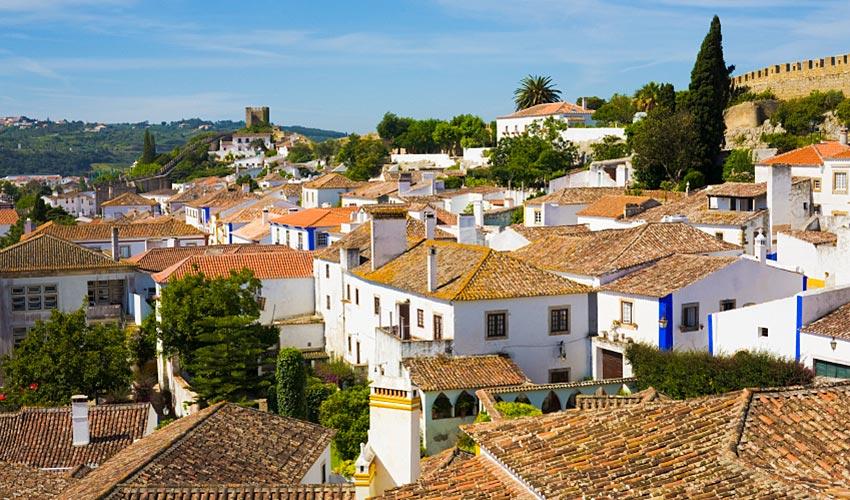Santarém is the lively capital of the Lezíria do Tejo sub-region (Lisboa e Vale do Tejo region). Unlike the Alentejo, this district is formed by vast, green plains that stretch to the horizon, often flooded by the river Tagus. While horse and bull breeding are amongst some of the region’s most proud traditions, Santarém is particularly famous for its bullfights and annual National Agricultural Fair.
The capital city of Santarém is home to a collection of interesting churches and to the popular Jardim das Portas do Sol – a garden encircled by the city’s medieval walls, affording magnificent views of the district’s plains and river. The quiet town of Golegã hosts a colourful annual horse fair, attracting large crowds of horse-lovers every November.
Amongst the endless, fertile plains that cover the Lezíria do Tejo lies the town of Alpiarça, commonly visited for its lovely parish church and Casa dos Patudos Museum – a fine arts museum exhibiting everything from paintings to decorative tiles. Also be sure to stop by the city of Almerim, best known for its wine and famous ‘sopa da pedra’ recipe, a delicious soup made of vegetables and meat, believed to have been invented by a begging monk.
Visit Tomar, a charming city with narrow, cobblestone streets, an old town atmosphere and beautiful gardens, bathed by the river Nabão. The Convento de Cristo, a dazzling convent containing a church and cloisters, is the city’s main attraction. Possessing a blend of architectural styles, this monument was built within the walls of Tomar’s Castle in 1162 by the Grand Master of the Templars.
Leisure walks, canoeing, fishing and water sports can all be enjoyed at the Castelo de Bode dam near Tomar, an area surrounded by secluded, little villages and lush eucalyptus forests. Visit the Sanctuary of Fátima too, believed to have been the place where three shepherd children witnessed the appearance of the Virgin Mary – a pilgrimage site that attracts thousands of devotees every year.
Places to See
Praça Barão da Batalha (Batalha’s Baron Square)
This square is one of Abrantes’ most popular spots and has become a favourite meeting point for visitors due to its dynamic commerce and constant liveliness – aspects that make this location one of the most attractive in the city.
Jardim do Castelo (The Castle Garden)
Best known as the ‘Flower City’, the lovely city of Abrantes owes its nickname to this garden – an enchanting space that still retains the beauty and charm of its past. This garden is an idyllic spot to enjoy relaxing leisure moments.
Fortaleza de Abrantes (Abrantes Fortress)
The fortress’ intriguing blend of architectural styles is a result of the countless military occupations that occurred in the district between 1173 and the second half of the 20th Century. One of the structure’s most dominant features is its keep, a tall tower commanding rare, panoramic views of the Ribatejo, Alentejo and Beira regions.
Igreja Matriz e Capela Dolmen (St. Mary Madeleine Church and Dolmen Chapel)
This religious monument is primarily visited for its unique, lateral chapel – an impressive dolmen (megalithic tomb) considered to be one of the ten largest in the Iberian Peninsula. Believed to have inspired the construction of the church, this megalithic chapel has become an important monument in the country.
Marinhas do Sal de Rio Maior (Rio Maior Salt Pans)
These salt pans are located in the foothills of the Candeeiros mountain range, surrounded by trees, vineyards and farmland. Located in an open-air space that resembles a small village because of its cobblestone passageways and wooden houses, the salt pans are situated 18 miles (30 kilometres) from the sea. Long ago, the range was flooded by the ocean, leaving fossils scattered around the whole area. Salt is produced between the months of July–September – the perfect time for your visit. Throughout the years, there has been little change in the traditional methods used in Rio Maior’s salt production process, making it especially unique.
Santuário de Nossa Senhora de Fátima (Fátima Sanctuary)
Fátima is undoubtedly the most revered pilgrimage site in the country, visited by people from all over the world in the name of ‘Faith, Life and Hope.’ This town is believed to be the place where the three shepherd children, Jacinta, Lúcia and Francisco, saw the Virgin Mary holding white rosary beads in Her hand and who asked them to pray against Evil. Nowadays, Fátima receives thousands of faithful pilgrims every year, especially on the 13th of May – an annual pilgrimage day. On these occasions, followers of the ‘Way to the Cross’ pilgrimage are led to 14 chapels – each one evoking the stages of the ‘Passion of Christ.’ This walk begins at the Santa Teresa de Ourém roundabout, leads to the ‘Valinhos’ monument (where the fourth apparition took place) and ends at the ‘Calvary’, having passed through the ‘Angel’s Cave’ (site where the Angel of Peace appeared twice to the shepherd children, in the spring and autumn of 1916).
Castelo de Ourém (Ourém Castle)
This castle is a fine example a beautiful medieval hamlet. Surrounded by walls, this grandiose monument sits at the top of a hill, just 2 kilometres from the town centre. To enter the castle you must access the ‘Portas da Vila’ (the original city gates).

 English
English  Português
Português  Deutsch
Deutsch 



